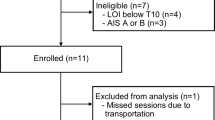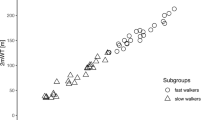Abstract
Study design:
Cross-sectional and longitudinal direct observation of a constrained consensus-building process in nine consumer panels and three rehabilitation professional panels.
Objectives:
To illustrate differences among consumer and clinician preferences for the restoration of walking function based on severity of injury, time of injury and age of the individual.
Setting:
Regional Spinal Cord Center in Philadelphia, USA.
Methods:
Twelve panels (consumer and clinical) came to independent consensus using the features–resource trade-off game. The procedure involves trading imagined levels of independence (resources) across different functional items (features) at different stages of recovery.
Results:
Walking is given priority early in the game by eight out of nine consumer panels and by two out of three professional panels. The exception consumer panel (ISCI<50) moved walking later in the game, whereas the exception professional panel (rehRx) moved wheelchair early but walking much delayed. Bowel and Bladder was given primary importance in all panels.
Conclusions:
Walking is a high priority for recovery among consumers with spinal cord injury irrespective of severity of injury, time of injury and age at time of injury. Among professional staff, walking is also of high priority except in rehabilitation professionals.
Similar content being viewed by others
Log in or create a free account to read this content
Gain free access to this article, as well as selected content from this journal and more on nature.com
or
References
National Institute on Disability and Rehabilitation Research. Notice of final long-range plan for fiscal years 2005–2009. Federal Register 2006; 71: 8166–8200.
The Rehabilitation Accreditation Commission http://www.carf.org/consumer.aspx?Content=Content/ConsumerServices/cs03en.html&ID, Accessed July 26, 2005.
Kennedy P, Hamilton LR . The needs assessment checklist: a clinical approach to measuring outcome. Spinal Cord 1999; 37: 136–139.
Duff J, Evans MJ, Kennedy P . Goal planning: a retrospective audit of rehabilitation processes and outcome. Clin Rehabil 2004; 18: 275–286.
Tate DG, Kalpakjian CZA, Forchheimer MB . Quality of life in individuals with spinal cord injury. Arch Phys Med Rehabil 2002; 83 (Suppl 2): S18–S25.
Manns PJ, Chad KE . Components of quality of life for persons with a quadriplegic and paraplegic spinal cord injury. Qual health Res 2001; 11: 795–811.
Dijkers MPJM, Whiteneck G, El-Jaroudi R . Measures of social outcomes in disability research. Arch Phys Med Rehabil 2000; 81 (Suppl 2): S63–S80.
Anderson K . Targeting recovery: priorities of the spinal cord-injured population. J Neurotrauma 2004; 21: 1371–1383.
Donnelly C, Eng JJ, Hall J, Alford L, Giachino R, Norton K et al. Client-centered assessment and the identification of meaningful treatment goals for individuals with a spinal cord injury. Spinal Cord 2004; 42: 302–307.
Estores IM . The consumer's perspective and the professional literature: what do persons with spinal cord injury want? J Rehabil Res Dev 2003; 40: 93–98.
Kilgore KL, Scherer M, Bobblitt R, Dettloff J, Dombrowski DM, Godbold N et al. Neuroprosthesis consumers' forum: consumer priorities for research direction. JRRD 2001; 38: 655–660.
Stineman MG, Maislin G, Nosek M, Fiedler R, Granger CV . Comparing consumer and clinician values for alternative functional states: application of a new feature trade-off consensus-building tool. Arch Phys Med Rehabil 1998; 79: 1522–1529.
Keith RA, Granger CV, Hamilton BB, Sherwin FS . The functional independence measure: a new tool for rehabilitation. Adv Clin Rehabil 1987; 1: 6–18.
Patrick M, Ditunno PL, Ditunno JF . A Comparison of spinal cord injury (SCI) consumers/staff preference for walking: a pilot study. J Spinal Cord Med 2003; 26: S41.
Catz A, Itzkovich M, Agranov E, Ring H, Tamir A . SCIM-spinal cord independence measure: a new disability scale for patients with spinal cord lesions. Spinal Cord 1997; 35: 850–856.
Ditunno PL, Patrick M, Stineman M, Morganti B, Townson AF, Ditunno JF . Cross-cultural differences in preference for recovery of mobility among spinal cord injury rehabilitation professionals. Spinal Cord 2006; 44: 567–575.
Glickman S, Kamm MA . Bowel dysfunction in spinal cord injury patients. Lancet 1996; 347: 1651–1653.
Hicken BL, Putzke JD, Richards JS . Bladder management and quality of life after spinal cord injury. Am J Phys Med Rehabil 2001; 80: 916–922.
Acknowledgements
This material was based on work supported by the National Institute on Disability and Rehabilitation Research, Office of Special Education and Rehabilitative Services, US Department of Education, grant no. H133N000023.
Author information
Authors and Affiliations
Corresponding author
Rights and permissions
About this article
Cite this article
Ditunno, P., Patrick, M., Stineman, M. et al. Who wants to walk? Preferences for recovery after SCI: a longitudinal and cross-sectional study. Spinal Cord 46, 500–506 (2008). https://doi.org/10.1038/sj.sc.3102172
Received:
Revised:
Accepted:
Published:
Issue date:
DOI: https://doi.org/10.1038/sj.sc.3102172
Keywords
This article is cited by
-
Assessing walking ability using a robotic gait trainer: opportunities and limitations of assist-as-needed control in spinal cord injury
Journal of NeuroEngineering and Rehabilitation (2023)
-
Exoskeleton-based training improves walking independence in incomplete spinal cord injury patients: results from a randomized controlled trial
Journal of NeuroEngineering and Rehabilitation (2023)
-
Utilization of overground exoskeleton gait training during inpatient rehabilitation: a descriptive analysis
Journal of NeuroEngineering and Rehabilitation (2023)
-
Performance of the Dutch clinical prediction rule for the ambulation outcome after spinal cord injury in a middle-income country clinical setting: an external validation study in the Thai retrospective cohort
Spinal Cord (2023)
-
Orthotic walking outcome of persons with motor complete low thoracic spinal cord injury—a retrospective study
Spinal Cord (2023)



